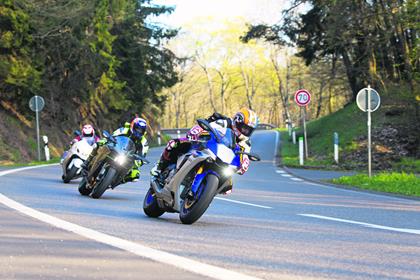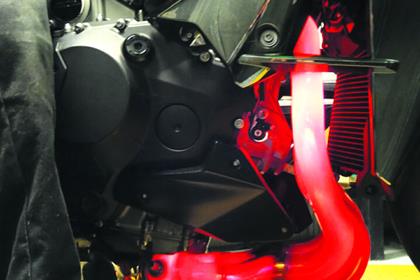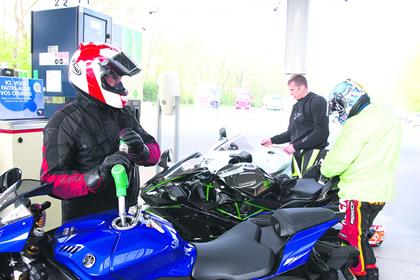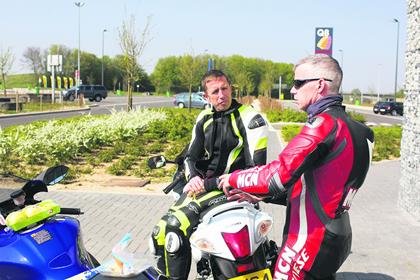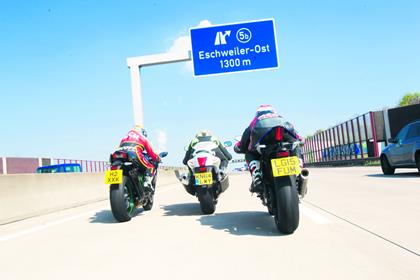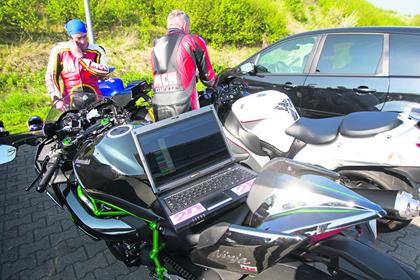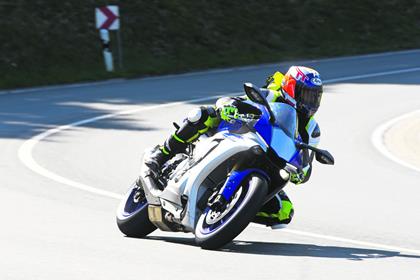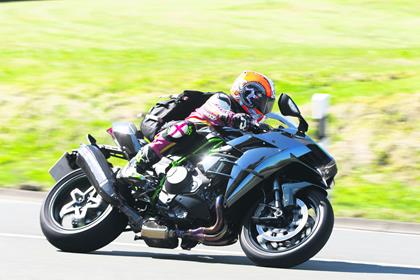FASTEST TEST EVER: Kawasaki H2 v Suzuki Hayabusa v Yamaha YZF-R1
Kawasaki’s H2 is the quickest production bike in history, but can it eclipse the Hayabusa and R1 on the ultimate road trip?
The Kawasaki H2 is choking on its leash, the throttle straining in my right hand as I hold the monstrous supercharger back. The digital speedo in indicating a calm 104mph, and I feel like I could step off and walk alongside. An imposing BMW 5-Series fills my horizon, its driver probably feeling that he’s tanking-on with three figures on the clock. But I want more. Come on Mr BMW, pull over.
I flick my left indicator on, signalling my intent, and his right indicator glows orange in response, as he begins to drift right with a lazy nonchalance that seems to say ‘I’m not bothered, you go faster if you want to’. I do want to. Back two gears to fourth, and the roar of air charging through the supercharger builds instantly as I steal a glance in my mirrors and roll the throttle back. The Busa and R1 are sat on each flank, close enough that you could throw a blanket over the three of us, but I’m about to stretch the arrow formation to breaking point.
That now-familiar surge is building beneath me as the clear stretch of unrestricted German autobahn unravels before me. I just have time to give Steve and Bruce a Barry Sheene-esque wave as I wind the H2’s throttle to the stop. The supercharger feels like it’s inhaling the horizon, the boost gauge confirming that I’ve got every horse the H2 can muster thrusting me forwards. The acceleration is immense, it feels like a superbike does from 60mph in second gear, but we’re doing well over the ton, and I’m in fourth. I keep the throttle pinned and fire home another gear with the quick-shifter. There’s no dip in the aggressive thrust, and as the clocks blitz through 150mph the Busa and R1 are shrinking in my mirrors like they’re both stuck in fourth gear.
There’s nothing ahead of me, and the conditions are perfect. I grab top gear, push my arse back against the seat unit and tuck in. This is it; 160, 170, 180. The H2 is still pulling hard. The inside lane is fading in my peripheral vision, the Busa and R1 are just specks. The Akrapovic is emitting a tortured howl, and still the supercharger crams air into the aluminium airbox. Bridges appear as thin as cables as they flash overhead, and suddenly I slam into the speed limiter like someone’s just slashed the fuel line. The speedo flicks dementedly between 186 and 187mph, and you can almost feel every fibre of the H2 apologising for the tease. It wants to give you everything, but can’t.
This is the fastest- accelerating production bike we’ve ever tested, and 200mph should be effortless without the artificial restriction; we already know that he H2R will cruise to over 221mph. I hold the Ninja on the limiter for 10 seconds or so, imprinting the experience of legally holding 187mph on a public road into my brain. It’s immense.
Stability isn’t an issue, tucked in behind the screen it feels calm, smooth and solid. All three of us are covering over three miles per minute, but it’s the H2 rewriting the history book on acceleration.
My eyes are locked on the horizon, and there are growing dots in the middle lane, cars that probably aren’t expecting my arrival at double their speed. I roll the throttle off and gently squeeze the brake lever. The calipers’ power is immense, and I’m back down to 100mph before my head can process the deceleration. I have to check the speedo twice, I feel like I’m crawling over the tarmac. Bruce and Steve are suddenly back with me, and the arrowhead reforms.
The aerodynamic Busa slithers alongside, and I can just make out Steve’s beaming face though his tinted visor. But the road ahead is suddenly clear again, and I cog back to fourth and the game starts afresh. Yes, the H2 has so much torque that I could have just rolled on in top, but I want to feel the full force again. We stretch out in line like an elastic band as the H2 stomps away again, but it’s sucking so much fuel that I have to back off before the limiter calls time. I ease the speed down to 70mph and wait for the others to close up before pointing to the H2’s filler cap, universal sign language for the most tedious job in motorcycling. We drift along in a post-carnal haze of tingling nervous excitement, and peel off into the first petrol station we spot.
![]() We’re like sugar-doped kids at the fuel stop, gabbling at each other at a million miles an hour. “That Kwak’s an absolute missile,” says a peaking Mercer, unable to stand still as he forces the words through his grin. The R1 and Busa are quick, each hitting their speed limiter with plenty in reserve, but the H2 gets there much faster. From a standing start the H2 will reach its terminal speed almost half-a-mile before the Hayabusa, and cuts the Yamaha’s 0-terminal figures in half. The H2 will reach 184mph from a standing start in just 900 metres. That’s extraordinary. At over 100mph it takes just a fraction over a second to add each 10mph until it hits the limiter; half the time the Hayabusa needs to reach a near-identical top speed. The R1 is surprisingly close to both up to 150mph, and loses nothing to the others in stability on Germany’s super-smooth autobahn, but can’t compete during that last 30mph.
We’re like sugar-doped kids at the fuel stop, gabbling at each other at a million miles an hour. “That Kwak’s an absolute missile,” says a peaking Mercer, unable to stand still as he forces the words through his grin. The R1 and Busa are quick, each hitting their speed limiter with plenty in reserve, but the H2 gets there much faster. From a standing start the H2 will reach its terminal speed almost half-a-mile before the Hayabusa, and cuts the Yamaha’s 0-terminal figures in half. The H2 will reach 184mph from a standing start in just 900 metres. That’s extraordinary. At over 100mph it takes just a fraction over a second to add each 10mph until it hits the limiter; half the time the Hayabusa needs to reach a near-identical top speed. The R1 is surprisingly close to both up to 150mph, and loses nothing to the others in stability on Germany’s super-smooth autobahn, but can’t compete during that last 30mph.
Nothing can match the craziness of the H2 – or it’s fuel consumption. We could have spent all day playing on the unrestricted German autobahns, but we couldn’t afford the fuel bill. With the H2 down to 23mpg or worse, we decided to head into the Eifel mountains to have some fun on real roads.
With speeds down to normal road pace, the Kawasaki’s biggest problem was the R1, it’s just so damn good. Our superbike group test winner feels and handles like a race 600, but with nearly 200bhp and GP-level electronics. It turns you into a riding god, boosts your confidence, and means you never feel like you’re approaching the limit, as you dive from one apex to the next with total confidence.
In contrast, the H2 feels reluctant to make the initial turn, craving straight lines. The weight feels higher up in the chassis, meaning you have put in more effort to make it turn. The Busa is longer and feels heavier, but carries it lower meaning it too flops into corners more naturally than the H2.
Once in a corner the H2 has more control than the Busa, the Suzuki soon starting to wallow and complain if the tarmac isn’t billiard-table smooth. The H2 is much more controlled mid-corner, meaning you can carry more lean and speed. It copes with road imperfections better, and you can even change your line mid-corner. Ask too much of the Suzuki and you’ll soon start to drag its fat undercarriage. But the R1 is leagues ahead of both.
Getting on the power on corner exits really highlights the differences between the three. The R1 is just a race bike on the road – huge power, brilliant suspension and intelligent electronics controlling everything. It’s so clever that it knows the difference between the tyre sliding sideways and spinning. Comparing the R1 to the Busa is like comparing the space shuttle to a steam engine.
While the Busa may be basic, its long wheelbase and feel from the rear tyre does allow you to search out the available grip. But with so much torque, rear traction can become an issue. Thankfully the fuelling is smooth and predictable – not something that can be said of the H2.
The biggest gripe with the Busa was its braking performance. Whether you’re snaking through a winding forest road, or covering a mile every 20 seconds, you need good stoppers. Sadly the Suzuki items are lacking by comparison, and the ABS kicks in way too early. Bruce even suggested the new ABS brakes are a step backwards over the old unassisted items. As Mercer pointed out: “You can have huge Brembo calipers, but that doesn’t mean anything when the ABS is too intrusive and the master cylinder is a decade old.”
As sinuous road miles click away, the Kawasaki’s fuelling starts to get quite annoying. It surges and lurches, and it’s hard to feed in the power smoothly in the first few gears. Once that ride-defining supercharger starts spinning, it just wants to go flat out until you’re bouncing off the limiter. Bruce compared it to a 500 two-stroke in feel, where there’s a slight delay followed by a rush of power. Some will like the fact it’s edgy and isn’t simple to ride, but others will be put off by the switch-like power delivery in the lower gears. Trying to slowly dial in the power at around 6000rpm in second or third is near impossible. Yes you have very clever electronics to control any slides or unwanted wheelies, and you can even turn the power down if you wish, but even experienced riders will find the H2 unforgiving, especially on an unfamiliar road at pace.
Away from the autobahns the Suzuki isn’t as comfortable as you’d think, the seat is wide and plush but the pegs are higher than you’d expect and the standard screen is low. The R1, however, was a real surprise. Considering its track credentials, the ergonomics aren’t too bad and there’s no reason why you couldn’t take on some serious miles on the R1.
The Kawasaki feels reasonably roomy, but obviously there’s no lower fairing to aid cooling purposes, night-time revealing that the downpipes can glow cherry red at motorway speeds. The screen is a little low, and there’s no pillion perch, but the biggest gripe was the poor fuel economy, and its resultant tank range. At normal motorway speeds the H2 averaged 31.43mpg compared to 45.45mpg on the Yamaha and 52.63mpg on the Suzuki. That gives the H2 a potential tank range of only 117 miles, the fuel light burning bright at 97 miles.
Up the pace to around 100mph for any distance and the H2 dips below 30mpg (with the fuel light illuminating at 84 miles) compared to the R1’s 37mpg and the Busa’s 42mpg. We had to stop to fuel the H2 nearly every hour on the run home from Germany.
Steve and Bruce didn’t favour the H2 around town either, both thought it was painful on the wrists, and the throttle woes are at their worst in the lower gears. Town riding soon became a pain, but most owners will simply put up with it in lieu of its other unique charms. No-one is going to care about the tank range or a slightly choppy throttle when they’ve got that supercharger to listen to as they ride the incredible tide of torque and power.
MCN VERDICT:
‘The H2’s like nothing else’
The H2 has its faults on the road, the recalcitrant throttle and surging power characteristics making it far from user friendly. It’s not an easy bike to just jump on and ride, and this all makes it far from ideal around town or on tight B-roads, while the tank range makes fast thrashes, or continent-crossing motorway blasts expensive. There’s so much that isn’t quite there with the H2, imperfections that detract from its excellence, but I still want it. Just look at it, it’s beautiful and ugly at the same time, like a Batman concept bike that’s made it into production by mistake. It sounds amazing and it’s the fastest-accelerating production bike on the planet. The R1 was a real surprise on this test. Included as a bit of useful context to help position the H2, it actually proved itself as an epic tourer and effortless in town.
But this test belongs to the H2. Yes, you can probably get to Germany and back faster on the Busa because you’ll need half the fuel stops, but deep down I’d always want to be on the Ninja H2: it accelerates, and communicates with your soul, in a way that nothing else on two wheels can.
![]()
